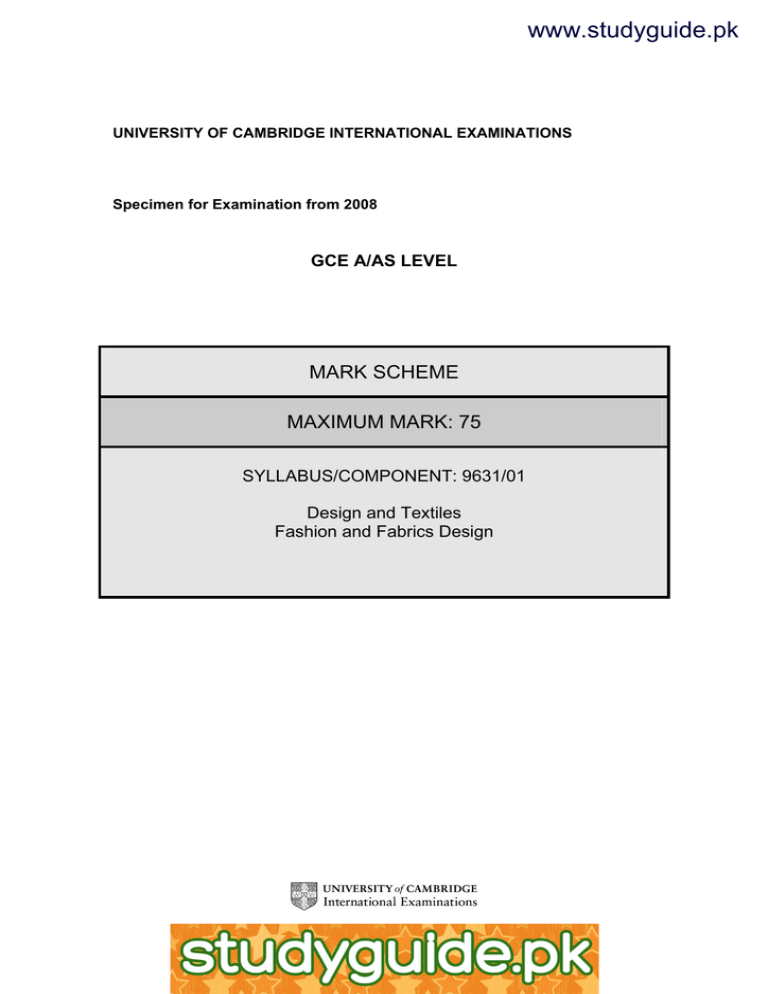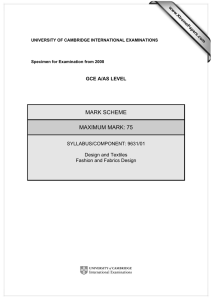www.xtremepapers.net www.studyguide.pk MARK SCHEME MAXIMUM MARK: 75
advertisement

www.studyguide.pk UNIVERSITY OF CAMBRIDGE INTERNATIONAL EXAMINATIONS Specimen for Examination from 2008 GCE A/AS LEVEL MARK SCHEME MAXIMUM MARK: 75 SYLLABUS/COMPONENT: 9631/01 Design and Textiles Fashion and Fabrics Design www.xtremepapers.net www.studyguide.pk Page 2 1 (a) Mark Scheme GCE A/AS LEVEL – 2008 Syllabus 9631 Describe the basic method of weaving. Paper 1 [4] Answer could include: Warp threads set up on loom; weft threads are wound onto shuttle (or water-jet/air jet etc); weft threads are interwoven with warp threads to form pattern on fabric. Selvedge produced at both edges of fabric; Diagram could be included to illustrate construction. (b) Explain, using sectional diagrams, how plain, twill and satin weaves are produced. [6] Answer could include: Diagrams should show the warp and weft thread positions (labelled) in each case: plain weave: twill weave: satin weave: (c) Compare the performance characteristics of twill weave fabrics with satin weave fabrics. [6] The candidate is able to compare the performance characteristics of twill weave and satin weave fabrics, and can give examples to illustrate. Answer could include: Twill weave fabrics are hardwearing, strong and drape well; more tightly woven; do not get dirty quickly, but can be more difficult to clean. Satin weave - diagonal lines are not obvious like in twill weave; flat, smooth; lustrous surface; warp more visible on right side of fabric; these floats are more susceptible to snagging; weaker fabric; the longer the float, the more likely it is to snag; shows signs of wear quickly; drape well; fabric is warmer than twill as it traps air between threads, so is good for lining fabrics. High band: 5 -6 marks Middle band: 2 - 4 marks Low band: 0 - 1 marks © University of Cambridge International Examinations 2006 www.xtremepapers.net www.studyguide.pk Page 3 (d) Mark Scheme GCE A/AS LEVEL – 2008 Syllabus 9631 Paper 1 Assess how fibre composition and yarn type may affect the performance characteristics of three named woven fabrics. [9] The candidate is able to assess how fibre composition and yarn type can affect the performance characteristics of three named woven fabrics. Answer could include: Fibre composition could include whether it is natural fibres (cotton, linen, silk or wool) or man-made fibres (Cellulosic e.g. viscose, acetate or synthetic e.g. nylon, polyester, acrylic). Yarn type could include whether it is a smooth yarn crepe yarn, “s” or “z” twist yarn; ply or fancy yarn. Performance characteristics could include: drape, handle, porosity; strength; durability etc. High band: 7 - 9 marks Middle band: 3 - 6 marks Low band: 0 - 2 marks 2 Fibres are widely used for textiles. (a) Describe briefly how one cellulosic and one protein fibre are obtained from their source. [2] The candidate should be able to state how one cellulosic and one protein fibre is obtained from its source. Answer could include: Cellulosic fibres could include: cotton, linen, viscose Protein fibres could include: wool and silk. For example, wool is obtained from sheep and the fleece is shorn; it is scoured to remove impurities and then sorted into length and colour; it is carded and combed; then it is produced into sliver, and spun into yarn. (b) Explain why there may be variations in fibre length and fineness in the fibres chosen in (a). [4] The candidate is able to give an explanation as to why there may be fibre variations in the fibres chosen in (a). Answers could include: Variations can occur in food/water consumed; climate; region where produced; method of obtaining fibres; variety of animal/plant. © University of Cambridge International Examinations 2006 www.xtremepapers.net www.studyguide.pk Page 4 (c) Mark Scheme GCE A/AS LEVEL – 2008 Syllabus 9631 Paper 1 Compare the differences between a range of natural and man-made fibres when carrying out microscopic examination. [9] The candidate is able to distinguish between the different fibres when carrying out microscopic examination. Answer could include: Fibres such as: Cotton, linen, silk, wool, viscose, acetate, nylon, polyester and acrylic. Microscopic examination could include longitudinal and cross section of each fibre. For example: cotton under microscope has bean-shaped cross section and LS looks like flattened twisted ribbon. High band: 7 - 9 marks Middle band: 3 - 6 marks Low band: 0 - 2 marks (d) Discuss why it is useful to know the moisture absorbency of fibres when relating it to (i) comfort and (ii) ease of care. [10] The candidate is able to discuss the reasons why it is useful to know the moisture absorbency of fibres for (i) comfort and (ii) ease of care. Answer could include: Comfort - next to skin comfort important especially in hot weather; cotton and viscose fibres have high absorbency rate, at 12% and 13% so they are able to absorb body moisture and allow it to evaporate into the air, so keeping the body cool. Ease of care - when a fabric has a low absorbency rate such as nylon is 4%, it means that less moisture is absorbed and less has to evaporate, so it is quicker drying. 3 Fashion is important to some people in today’s society. (a) Briefly outline what is meant by the term “fashion”. [2] The candidate will be able to outline what is meant by the term fashion. Answer could include: Clothing which covers the human body to provide a micro-climate but is also aesthetically pleasing. Can also show an individual’s status in society. Fashion changes regularly to keep up with latest trends and technological advances. (b) Describe four factors which can influence aspects of fashion in contemporary society. [4] The candidate will be able to describe four factors which can influence the choice of fashion designs in contemporary society. Answer could include: Season; colour trends; fabric trends; seasons (winter/summer); type of clothing to be designed (e.g. evening/sports wear); cultural influences; Examples could be included. © University of Cambridge International Examinations 2006 www.xtremepapers.net www.studyguide.pk Page 5 (c) Mark Scheme GCE A/AS LEVEL – 2008 Syllabus 9631 Paper 1 Discuss how fashion trends may be revived from past years, giving specific examples. [9] The candidate will be able to discuss how fashion trends may be revived from past years and give specific examples. Answer could include: “Retro” fashion trends in Autumn 2005, based on colours and styles from 1940’s British and American movies. Fabrics used, are wool tweed, in a variety of colours. Colours used are browns and beiges; Garments include tailored jackets and skirts. High band: 7 - 9 marks Middle band: 3 - 6 marks Low band: 0 -2 marks (d) Assess the merits of a range of retail outlets available in the high street or main shopping area, for fashion goods. [10] The candidate will be able to assess the merits of a range of retail outlets available in the high street or main shopping area, for fashion goods. Answer could include: Retail outlets could include department stores, chain stores in the capital city and major towns; individual boutiques; market stalls. A discussion of the advantages and disadvantages of a range of examples given. High band: 8 - 10 marks Middle band: 4 - 7 marks Low band: 0 - 3 marks 4 A variety of processes are used in clothing manufacture. (a) Briefly outline how lay planning is carried out in the clothing industry (home-based and industrial. [3] The candidate will be able to outline how lay planning is carried out in the clothing industry. Answer could include: Computer used to store pattern piece shapes; moved using the mouse; most economical layout can be calculated; one-way designs can be shown on screen; different fabric widths can be calculated. © University of Cambridge International Examinations 2006 www.xtremepapers.net www.studyguide.pk Page 6 (b) Mark Scheme GCE A/AS LEVEL – 2008 Syllabus 9631 Paper 1 Compare the methods of marking fabrics before assembly, for a one-off item and a mass produced item. [4] The candidate will be able to compare the methods of marking fabrics before assembly for a one-off item and a mass produced item. Answer could include: One-off item: tailor-tacking by hand; slow and only one marking can be done at a time; marking may not be accurate; markings may dislodge during making-up of item; Mass produced item: many layers are marked at a time; very accurate; notched edge of fabric may be used; mark is permanent but not visible on right side of garment. (c) Assess the range of sewing machines available at home and in industry, for product assembly. [6] The candidate will be able to assess the range of sewing machine available in industry, for product assembly. Answer could include: Overlocking machine used to finish edges, carry out gathering, top stitch jersey fabrics Straight stitch sewing machine to sew seams and carry out top stitching; Zig-zag machines - used to attach lace and sew other motifs; Buttonhole machine to sew buttonholes; Bar tack machine to stitch bar tacks on corners of pockets; High band: 5 -6 marks Middle band: 3 - 4 marks Low band: 0 - 2 marks (d) Explain how a range of edge finishes can be carried out by machine in the clothing industry. The candidate will be able to explain how a range of edge finishes can be carried out by machine in the clothing industry. Answer could include: Finishes can be achieved: top-stitched hem may be overlocked using an overlocking machine, the top edge will be turned towards wrong wide and a row of top-stitching will be stitched using a straight-stitch machine. A lace hem may be overlocked, using an overlocker; then the lace will be attached using a zig-zag machine and the edge will remain flat. Sketches could be included to illustrate different methods of carrying out hems by machine. High band: 9 - 12 marks Middle band: 5 - 8 marks Low band: 0 - 4 marks © University of Cambridge International Examinations 2006 www.xtremepapers.net [12]






